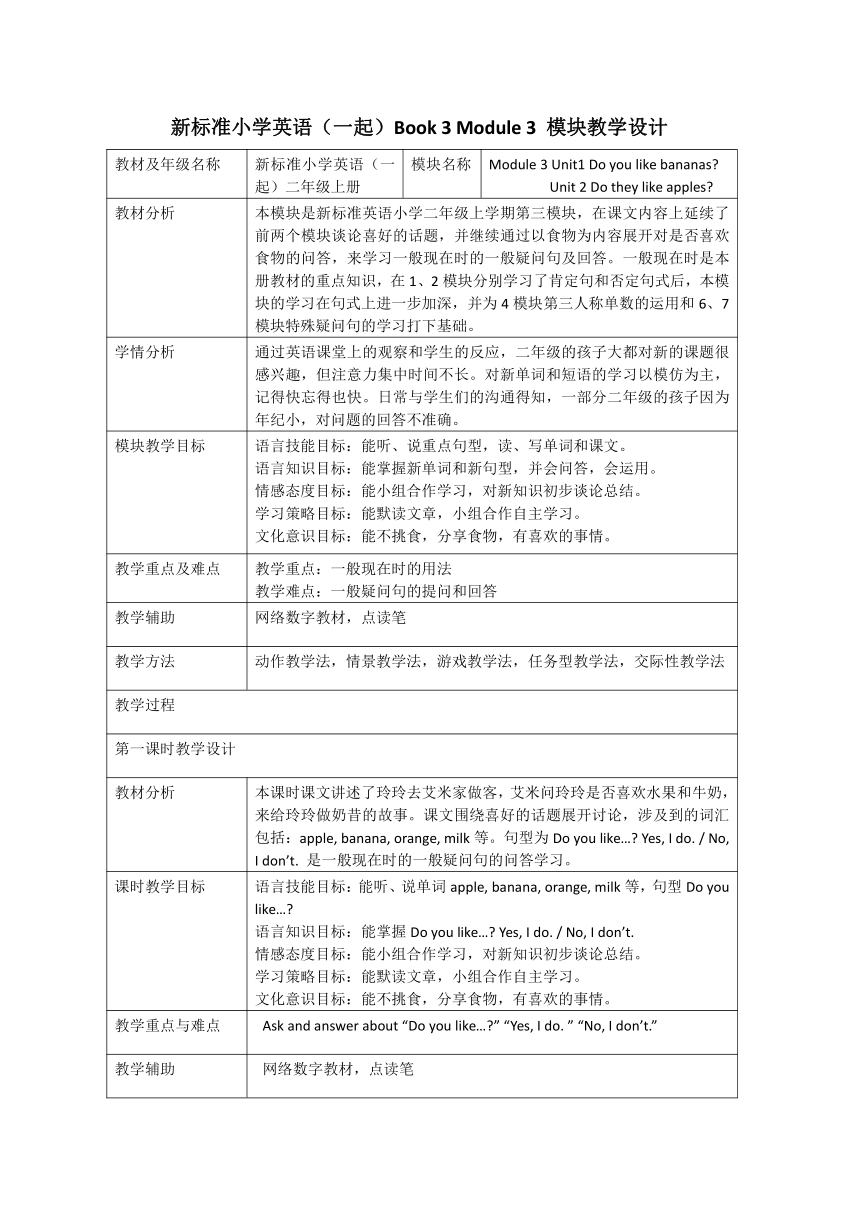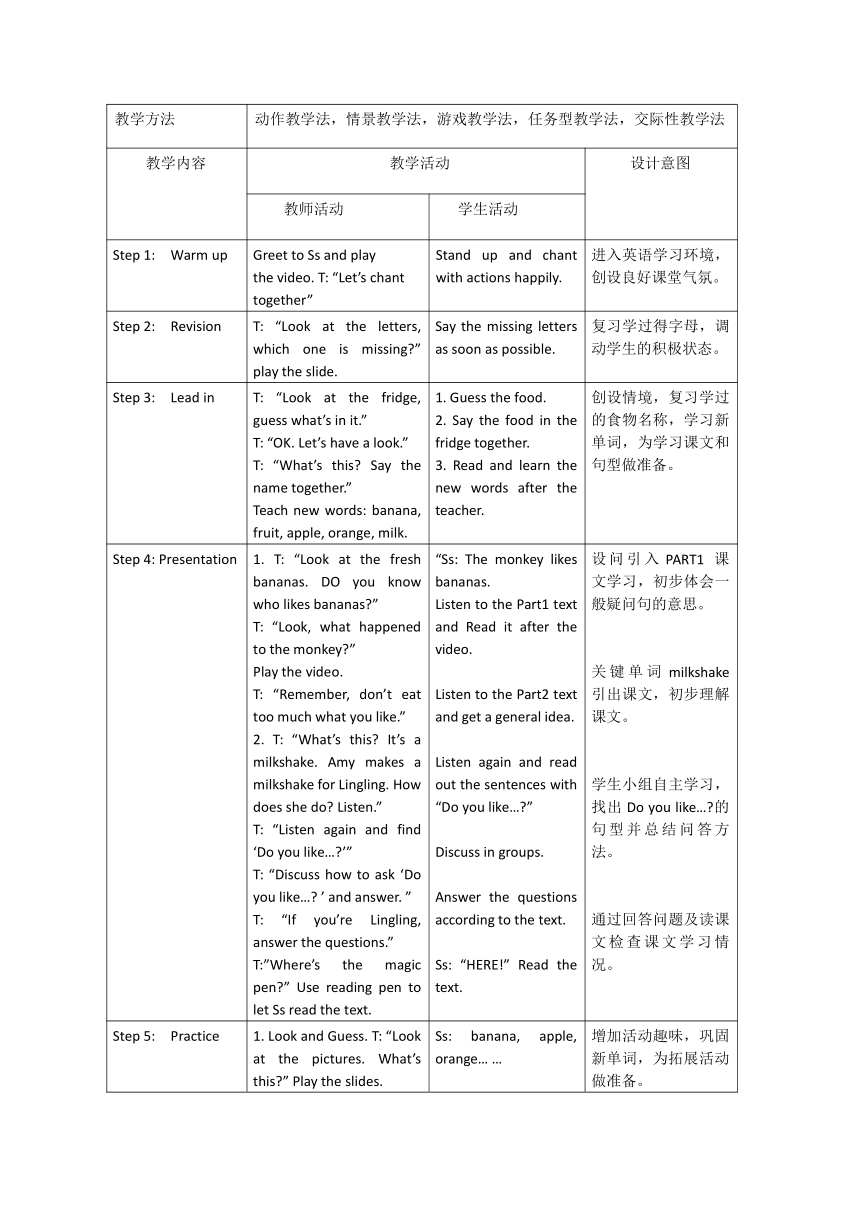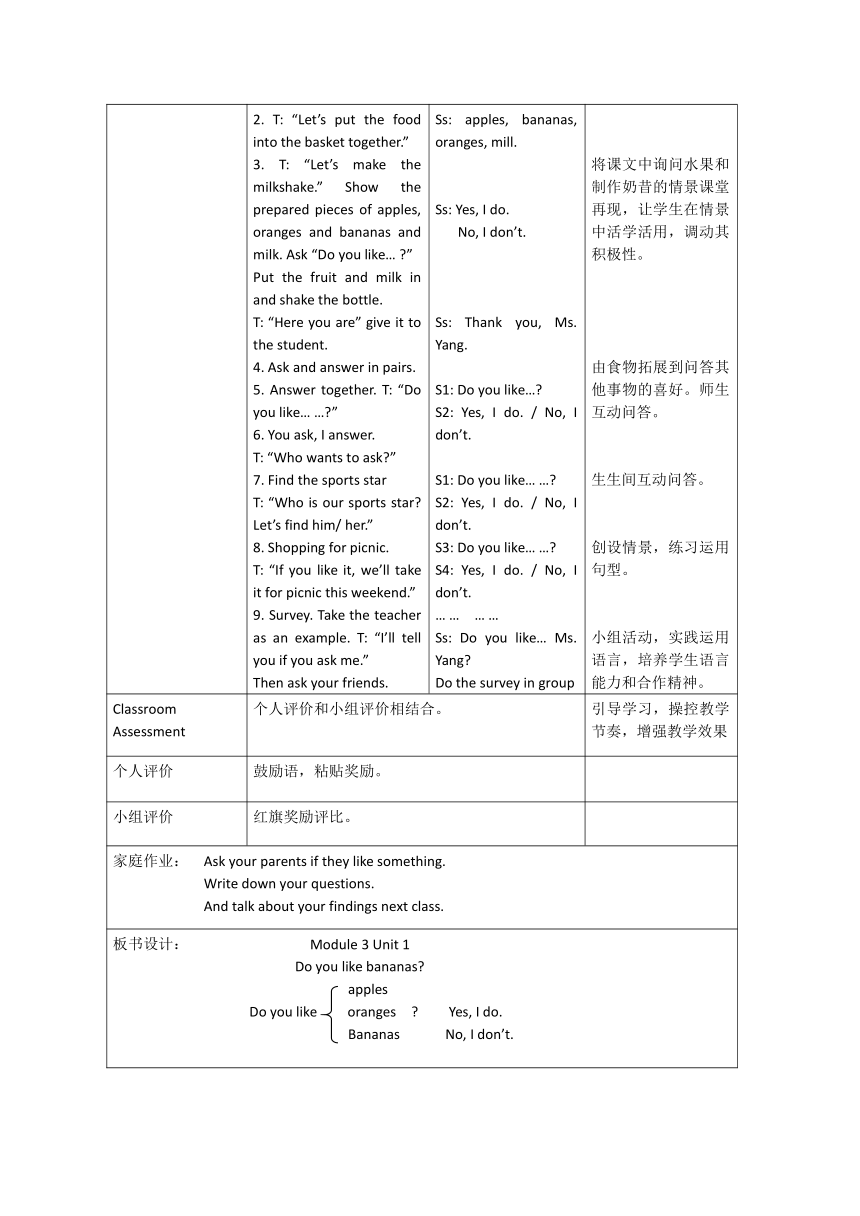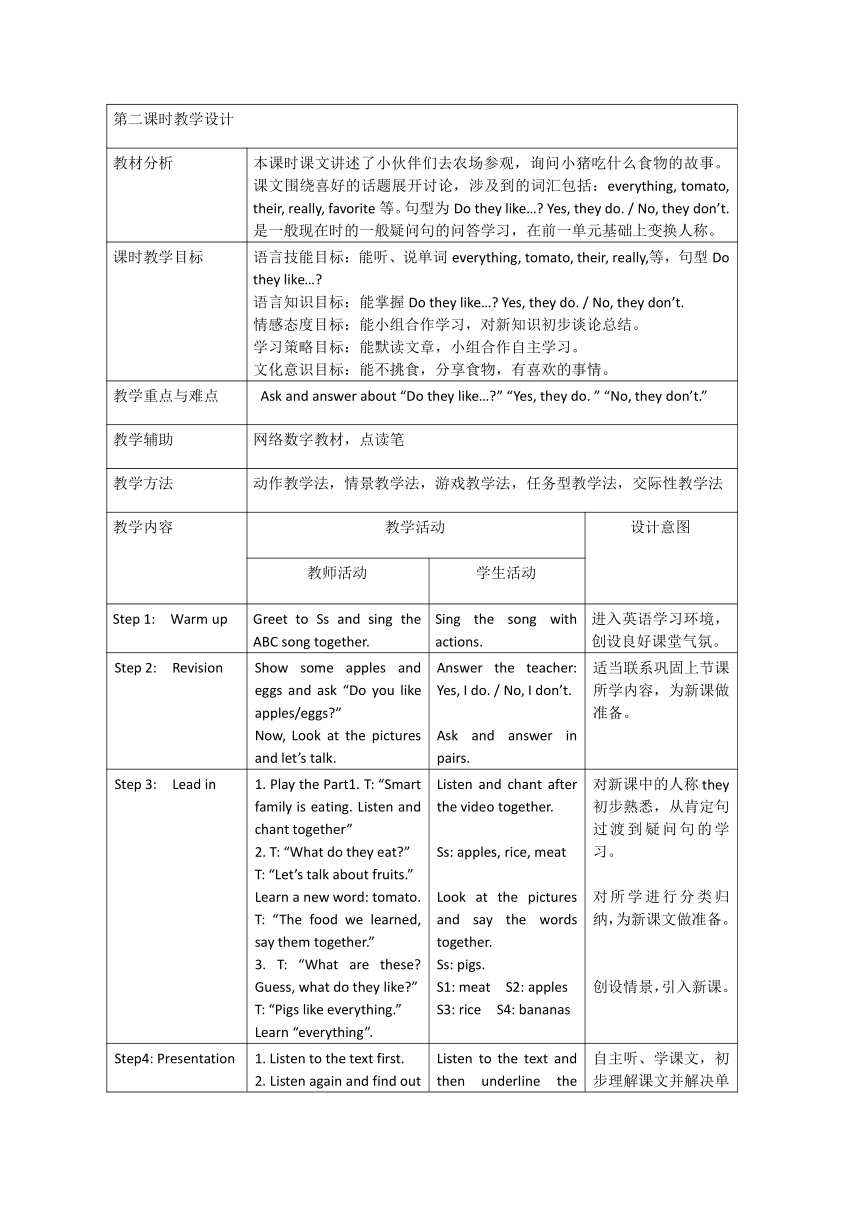外研版(一年级起点)二年级英语上册 Module 3表格式教案
文档属性
| 名称 | 外研版(一年级起点)二年级英语上册 Module 3表格式教案 |  | |
| 格式 | doc | ||
| 文件大小 | 123.5KB | ||
| 资源类型 | 教案 | ||
| 版本资源 | 外研版(一年级起点) | ||
| 科目 | 英语 | ||
| 更新时间 | 2021-09-23 14:18:09 | ||
图片预览




文档简介
新标准小学英语(一起)Book
3
Module
3
模块教学设计
教材及年级名称
新标准小学英语(一起)二年级上册
模块名称
Module
3
Unit1
Do
you
like
bananas?
Unit
2
Do
they
like
apples?
教材分析
本模块是新标准英语小学二年级上学期第三模块,在课文内容上延续了前两个模块谈论喜好的话题,并继续通过以食物为内容展开对是否喜欢食物的问答,来学习一般现在时的一般疑问句及回答。一般现在时是本册教材的重点知识,在1、2模块分别学习了肯定句和否定句式后,本模块的学习在句式上进一步加深,并为4模块第三人称单数的运用和6、7模块特殊疑问句的学习打下基础。
学情分析
通过英语课堂上的观察和学生的反应,二年级的孩子大都对新的课题很感兴趣,但注意力集中时间不长。对新单词和短语的学习以模仿为主,记得快忘得也快。日常与学生们的沟通得知,一部分二年级的孩子因为年纪小,对问题的回答不准确。
模块教学目标
语言技能目标:能听、说重点句型,读、写单词和课文。语言知识目标:能掌握新单词和新句型,并会问答,会运用。情感态度目标:能小组合作学习,对新知识初步谈论总结。学习策略目标:能默读文章,小组合作自主学习。文化意识目标:能不挑食,分享食物,有喜欢的事情。
教学重点及难点
教学重点:一般现在时的用法教学难点:一般疑问句的提问和回答
教学辅助
网络数字教材,点读笔
教学方法
动作教学法,情景教学法,游戏教学法,任务型教学法,交际性教学法
教学过程
第一课时教学设计
教材分析
本课时课文讲述了玲玲去艾米家做客,艾米问玲玲是否喜欢水果和牛奶,来给玲玲做奶昔的故事。课文围绕喜好的话题展开讨论,涉及到的词汇包括:apple,
banana,
orange,
milk等。句型为Do
you
like…?
Yes,
I
do.
/
No,
I
don’t.
是一般现在时的一般疑问句的问答学习。
课时教学目标
语言技能目标:能听、说单词apple,
banana,
orange,
milk等,句型Do
you
like…?语言知识目标:能掌握Do
you
like…?
Yes,
I
do.
/
No,
I
don’t.情感态度目标:能小组合作学习,对新知识初步谈论总结。学习策略目标:能默读文章,小组合作自主学习。文化意识目标:能不挑食,分享食物,有喜欢的事情。
教学重点与难点
Ask
and
answer
about
“Do
you
like…?”
“Yes,
I
do.
”
“No,
I
don’t.”
教学辅助
网络数字教材,点读笔
教学方法
动作教学法,情景教学法,游戏教学法,任务型教学法,交际性教学法
教学内容
教学活动
设计意图
教师活动
学生活动
Step
1:
Warm
up
Greet
to
Ss
and
playthe
video.
T:
“Let’s
chanttogether”
Stand
up
and
chant
with
actions
happily.
进入英语学习环境,创设良好课堂气氛。
Step
2:
Revision
T:
“Look
at
the
letters,
which
one
is
missing?”
play
the
slide.
Say
the
missing
letters
as
soon
as
possible.
复习学过得字母,调动学生的积极状态。
Step
3:
Lead
in
T:
“Look
at
the
fridge,
guess
what’s
in
it.”T:
“OK.
Let’s
have
a
look.”
T:
“What’s
this?
Say
the
name
together.”Teach
new
words:
banana,
fruit,
apple,
orange,
milk.
1.
Guess
the
food.2.
Say
the
food
in
the
fridge
together.3.
Read
and
learn
the
new
words
after
the
teacher.
创设情境,复习学过的食物名称,学习新单词,为学习课文和句型做准备。
Step
4:
Presentation
1.
T:
“Look
at
the
fresh
bananas.
DO
you
know
who
likes
bananas?”T:
“Look,
what
happened
to
the
monkey?”
Play
the
video.T:
“Remember,
don’t
eat
too
much
what
you
like.”2.
T:
“What’s
this?
It’s
a
milkshake.
Amy
makes
a
milkshake
for
Lingling.
How
does
she
do?
Listen.”T:
“Listen
again
and
find
‘Do
you
like…?’”
T:
“Discuss
how
to
ask
‘Do
you
like…?
’
and
answer.
”T:
“If
you’re
Lingling,
answer
the
questions.”T:”Where’s
the
magic
pen?”
Use
reading
pen
to
let
Ss
read
the
text.
“Ss:
The
monkey
likes
bananas.Listen
to
the
Part1
text
and
Read
it
after
the
video.Listen
to
the
Part2
text
and
get
a
general
idea.Listen
again
and
read
out
the
sentences
with
“Do
you
like…?”Discuss
in
groups.Answer
the
questions
according
to
the
text.Ss:
“HERE!”
Read
the
text.
设问引入PART1
课文学习,初步体会一般疑问句的意思。关键单词milkshake引出课文,初步理解课文。学生小组自主学习,找出Do
you
like…?的句型并总结问答方法。通过回答问题及读课文检查课文学习情况。
Step
5:
Practice
1.
Look
and
Guess.
T:
“Look
at
the
pictures.
What’s
this?”
Play
the
slides.2.
T:
“Let’s
put
the
food
into
the
basket
together.”3.
T:
“Let’s
make
the
milkshake.”
Show
the
prepared
pieces
of
apples,
oranges
and
bananas
and
milk.
Ask
“Do
you
like…
?”Put
the
fruit
and
milk
in
and
shake
the
bottle.
T:
“Here
you
are”
give
it
to
the
student.4.
Ask
and
answer
in
pairs.5.
Answer
together.
T:
“Do
you
like…
…?”6.
You
ask,
I
answer.
T:
“Who
wants
to
ask?”
7.
Find
the
sports
starT:
“Who
is
our
sports
star?
Let’s
find
him/
her.”8.
Shopping
for
picnic.T:
“If
you
like
it,
we’ll
take
it
for
picnic
this
weekend.”9.
Survey.
Take
the
teacher
as
an
example.
T:
“I’ll
tell
you
if
you
ask
me.”Then
ask
your
friends.
Ss:
banana,
apple,
orange…
…Ss:
apples,
bananas,
oranges,
mill.Ss:
Yes,
I
do.
No,
I
don’t.Ss:
Thank
you,
Ms.
Yang.S1:
Do
you
like…?S2:
Yes,
I
do.
/
No,
I
don’t.S1:
Do
you
like…
…?S2:
Yes,
I
do.
/
No,
I
don’t.S3:
Do
you
like…
…?S4:
Yes,
I
do.
/
No,
I
don’t.…
…
…
…Ss:
Do
you
like…
Ms.
Yang?Do
the
survey
in
group
增加活动趣味,巩固新单词,为拓展活动做准备。将课文中询问水果和制作奶昔的情景课堂再现,让学生在情景中活学活用,调动其积极性。由食物拓展到问答其他事物的喜好。师生互动问答。生生间互动问答。创设情景,练习运用句型。小组活动,实践运用语言,培养学生语言能力和合作精神。
Classroom
Assessment
个人评价和小组评价相结合。
引导学习,操控教学节奏,增强教学效果
个人评价
鼓励语,粘贴奖励。
小组评价
红旗奖励评比。
家庭作业:
Ask
your
parents
if
they
like
something.
Write
down
your
questions.
And
talk
about
your
findings
next
class.
板书设计:
Module
3
Unit
1Do
you
like
bananas?
apples
Do
you
like
oranges
?
Yes,
I
do.
Bananas
No,
I
don’t.
第二课时教学设计
教材分析
本课时课文讲述了小伙伴们去农场参观,询问小猪吃什么食物的故事。课文围绕喜好的话题展开讨论,涉及到的词汇包括:everything,
tomato,
their,
really,
favorite等。句型为Do
they
like…?
Yes,
they
do.
/
No,
they
don’t.
是一般现在时的一般疑问句的问答学习,在前一单元基础上变换人称。
课时教学目标
语言技能目标:能听、说单词everything,
tomato,
their,
really,等,句型Do
they
like…?语言知识目标:能掌握Do
they
like…?
Yes,
they
do.
/
No,
they
don’t.情感态度目标:能小组合作学习,对新知识初步谈论总结。学习策略目标:能默读文章,小组合作自主学习。文化意识目标:能不挑食,分享食物,有喜欢的事情。
教学重点与难点
Ask
and
answer
about
“Do
they
like…?”
“Yes,
they
do.
”
“No,
they
don’t.”
教学辅助
网络数字教材,点读笔
教学方法
动作教学法,情景教学法,游戏教学法,任务型教学法,交际性教学法
教学内容
教学活动
设计意图
教师活动
学生活动
Step
1:
Warm
up
Greet
to
Ss
and
sing
the
ABC
song
together.
Sing
the
song
with
actions.
进入英语学习环境,创设良好课堂气氛。
Step
2:
Revision
Show
some
apples
and
eggs
and
ask
“Do
you
like
apples/eggs?”Now,
Look
at
the
pictures
and
let’s
talk.
Answer
the
teacher:
Yes,
I
do.
/
No,
I
don’t.Ask
and
answer
in
pairs.
适当联系巩固上节课所学内容,为新课做准备。
Step
3:
Lead
in
1.
Play
the
Part1.
T:
“Smart
family
is
eating.
Listen
and
chant
together”2.
T:
“What
do
they
eat?”T:
“Let’s
talk
about
fruits.”Learn
a
new
word:
tomato.T:
“The
food
we
learned,
say
them
together.”3.
T:
“What
are
these?
Guess,
what
do
they
like?”T:
“Pigs
like
everything.”Learn
“everything”.
Listen
and
chant
after
the
video
together.Ss:
apples,
rice,
meatLook
at
the
pictures
and
say
the
words
together.Ss:
pigs.S1:
meat
S2:
applesS3:
rice
S4:
bananas
对新课中的人称they初步熟悉,从肯定句过渡到疑问句的学习。对所学进行分类归纳,为新课文做准备。创设情景,引入新课。
Step4:
Presentation
1.
Listen
to
the
text
first.2.
Listen
again
and
find
out
the
new
words.Show
and
teach
the
new
words.3.
T:
”Where’s
the
magic
pen?”
Use
reading
pen
to
let
Ss
read
the
text.Read
the
text
in
groups.4.
Read
the
text
by
different
roles.5.
Dub
the
text.
Listen
to
the
text
and
then
underline
the
new
words
when
finding
them.Learn
the
words
in
groups.Ss:
“HERE!”
Read
the
text.
自主听、学课文,初步理解课文并解决单词问题。训练学生读的能力,并培养语音语调的掌握和表演能力。
Step5:
Practice
1.
Luck
rounding.
T:
“Say
the
words
together.”2.
Let
students
answer
the
questions
based
on
the
pictures
and
knowledge.T:”
Do
they
like
bananas?”T:
“Do
they
like
rice?”T:
“Do
they
like
fish?”T:
“Do
they
like
grass?”…
…
…
…
3.
Magic
package.T:
“Behind
each
package,
there
will
be
a
surprise.
Who
guesses
the
right
answer
will
get
it.
Come
on.”T:
“Yes,
they
do.
/
No,
they
don’t.
”4.
Group
work.
Draw
a
picture
to
talk
about
what
your
families
like.
Say
and
share
in
front
of
the
class.
Say
the
words
as
soon
as
possible.S1:
Yes,
they
do.S2:
No,
they
don’t.S3:
No,
they
don’t.S4:
Yes,
they
do.S1:
Do
they
like
cakes?S2:
Do
they
like
green?S3:
Do
they
like
shoes?S4:
Do
they
like
birds?…
…
…
…Ss:
They
like…
…
增加活动趣味,提高学习练习积极性,巩固新单词。拓展No,
they
don’t的学习和练习。师生互动。增加活动趣味,提高学习练习积极性,巩固句型运用。语言运用能力和小组合作能力拓展。
Classroom
Assessment
个人评价和小组评价相结合。
引导学习,操控教学节奏,增强教学效果
个人评价
鼓励语,粘贴奖励。
小组评价
红旗奖励评比。
家庭作业:
Draw
a
picture
to
talk
about
what
you
like
and
what
your
families
like.Say
and
share
with
others.
板书设计:
Module
3
Unit
2Do
they
like
apples?
apples
?Do
they
like
Yes,
they
do.
oranges
?
No,
they
don’t.
第三课时教学设计
教材分析
本课时以第一单元和第二单元的课文为基础,围绕课后练习进行游戏和拓展。涉及到第一、二单元的单词和学过单词的拓展,句型为Do
you/they
like…?
Yes,
I
/
they
do.
No,
I
/
they
don’t.
是一般现在时的一般疑问句的问答学习,人称变换和句型变换。
课时教学目标
语言技能目标:能听、说重点单词,读、写字母和重点句型。语言知识目标:能掌握一般疑问句的问答。情感态度目标:能小组合作学习,对新知识初步谈论总结。学习策略目标:能默读文章,小组合作自主学习。文化意识目标:能不挑食,分享食物,有喜欢的事情。
教学重点与难点
一般现在时一般疑问句的问答,肯定句和疑问句的转换。
教学辅助
网络数字教材
教学方法
情景教学法,游戏教学法,任务型教学法,交际性教学法,总结法
教学内容
教学活动
设计意图
教师活动
学生活动
Step
1:
Listening
Play
the
video
and
let
students
listen
and
check
√
or
×.Listen
again
with
students.Check
the
answers.
Listen
and
draw
√
or
×.Check
the
answers.
训练重点句型的听力理解和运用。
Step
2:
Repeat
Team
work.Let
one
student
of
each
team
repeat
the
learned
texts
based
on
the
pictures
of
texts.
Show
the
pictures
and
some
parts
of
sentences
to
help
students
to
repeat.
Look
at
the
pictures
and
fill
the
blanks
to
finish
the
sentences.
复习课文,加深对知识点的记忆。小组竞争模式,提高学生的积极性。
Step
3:
Speaking
Ask
and
answer.Let
students
show
the
drawing
yesterday
and
talk
about
the
pictures
using
learned
sentence
patterns.Let
other
students
to
ask.
Show
the
pictures.Talk
about
the
picturesS1:
Please
ask
me.S2:
Do
you
like
apples?S1:
Yes,
I
do.S3:
Do
they
like…?
检查作业情况,运用学习资源,练习重点句型问答。生生互动。
Step4:
Writing
1.
Letter
writingListen
and
say
the
letter.
And
Let
students
practice
writing
letters.2.Sentence
pattern
changeGive
students
examples
first
and
let
students
change
the
sentence
into
questions
and
answer
the
questions.
Write
down
the
letters.Write
down
the
sentences
and
check
them
in
pairs.
字母书写训练。加深句型理解,进行书写训练。
Step5:
Playing
Finish
the
activities
on
textbook.1.
Practice6.
Guess,
ask
and
answer.
Let
one
student
hold
an
apple
or
orange
in
front
of
the
class.
Let
others
ask
by
saying
“Do
you
like…”
to
get
the
answers.
2.
Practice7.
Group
work.
Make
a
lunch
menu.
Let
students
design
a
menu
each
group
by
asking
the
food
like
and
dislike.Show
the
menu.
S1:
Do
you
like
bananas?S2:
No,
I
don’t.S3:
Do
you
like
oranges?S2:
No,
I
don’t.S4:
Do
you
like
apples?S2:
Yes,
I
do.S1:
Do
you
like
apples?S2:
No,
I
don’t.S1:
Do
you
like
rice?S3:
Yes,
I
do.
将句型训练设置于游戏中,增强活动的趣味性,促进学生练习的积极性。生生互动。创设情景,在生活实际中进行句型使用训练。
Step6:
Sum
up
Let
students
say
what
they
learn
in
this
module.
Lead
them
form
a
knowledge
tree.Draw
the
tree
on
the
blackboard.
Say
the
knowledge
points
when
think
out
in
this
module.
充分发展学生的学习主动性和能动性,拓展思路,自主归纳总结所学,形成知识体系。
Classroom
Assessment
个人评价和小组评价相结合。
引导学习,操控教学节奏,增强教学效果
个人评价
鼓励语,粘贴奖励。
小组评价
红旗奖励评比。
家庭作业:
Reading
on
New
Standard
English
APP.
板书设计:
Module
3
Do
you
like…?
Yes,
I
do.
/
No,
I
don’t.
Do
they
like…?
Yes,
they
do.
/
No,
I
don’t.
模块整体教学反思:本模块教学以一、二课时的新授和第三课时的练习拓展构成。在第一课时中,将句型教学设置于真正的制作奶昔的情景中,学生学习热情高涨,句型的问答学习水到聚成,但值得注意的是在小组活动中忽略的后进学生的启发,练习部分过多。在第二课时中注意了此方面的调整,适当控制课堂节奏和练习数量,让全员都能参与活动,教学效果较好。在复习课时中,将人称变化和句式变化系统化,注意了听说读写的综合训练,在头脑风暴式的归纳总结后,教学目标充分落实,教学效果较好。
3
Module
3
模块教学设计
教材及年级名称
新标准小学英语(一起)二年级上册
模块名称
Module
3
Unit1
Do
you
like
bananas?
Unit
2
Do
they
like
apples?
教材分析
本模块是新标准英语小学二年级上学期第三模块,在课文内容上延续了前两个模块谈论喜好的话题,并继续通过以食物为内容展开对是否喜欢食物的问答,来学习一般现在时的一般疑问句及回答。一般现在时是本册教材的重点知识,在1、2模块分别学习了肯定句和否定句式后,本模块的学习在句式上进一步加深,并为4模块第三人称单数的运用和6、7模块特殊疑问句的学习打下基础。
学情分析
通过英语课堂上的观察和学生的反应,二年级的孩子大都对新的课题很感兴趣,但注意力集中时间不长。对新单词和短语的学习以模仿为主,记得快忘得也快。日常与学生们的沟通得知,一部分二年级的孩子因为年纪小,对问题的回答不准确。
模块教学目标
语言技能目标:能听、说重点句型,读、写单词和课文。语言知识目标:能掌握新单词和新句型,并会问答,会运用。情感态度目标:能小组合作学习,对新知识初步谈论总结。学习策略目标:能默读文章,小组合作自主学习。文化意识目标:能不挑食,分享食物,有喜欢的事情。
教学重点及难点
教学重点:一般现在时的用法教学难点:一般疑问句的提问和回答
教学辅助
网络数字教材,点读笔
教学方法
动作教学法,情景教学法,游戏教学法,任务型教学法,交际性教学法
教学过程
第一课时教学设计
教材分析
本课时课文讲述了玲玲去艾米家做客,艾米问玲玲是否喜欢水果和牛奶,来给玲玲做奶昔的故事。课文围绕喜好的话题展开讨论,涉及到的词汇包括:apple,
banana,
orange,
milk等。句型为Do
you
like…?
Yes,
I
do.
/
No,
I
don’t.
是一般现在时的一般疑问句的问答学习。
课时教学目标
语言技能目标:能听、说单词apple,
banana,
orange,
milk等,句型Do
you
like…?语言知识目标:能掌握Do
you
like…?
Yes,
I
do.
/
No,
I
don’t.情感态度目标:能小组合作学习,对新知识初步谈论总结。学习策略目标:能默读文章,小组合作自主学习。文化意识目标:能不挑食,分享食物,有喜欢的事情。
教学重点与难点
Ask
and
answer
about
“Do
you
like…?”
“Yes,
I
do.
”
“No,
I
don’t.”
教学辅助
网络数字教材,点读笔
教学方法
动作教学法,情景教学法,游戏教学法,任务型教学法,交际性教学法
教学内容
教学活动
设计意图
教师活动
学生活动
Step
1:
Warm
up
Greet
to
Ss
and
playthe
video.
T:
“Let’s
chanttogether”
Stand
up
and
chant
with
actions
happily.
进入英语学习环境,创设良好课堂气氛。
Step
2:
Revision
T:
“Look
at
the
letters,
which
one
is
missing?”
play
the
slide.
Say
the
missing
letters
as
soon
as
possible.
复习学过得字母,调动学生的积极状态。
Step
3:
Lead
in
T:
“Look
at
the
fridge,
guess
what’s
in
it.”T:
“OK.
Let’s
have
a
look.”
T:
“What’s
this?
Say
the
name
together.”Teach
new
words:
banana,
fruit,
apple,
orange,
milk.
1.
Guess
the
food.2.
Say
the
food
in
the
fridge
together.3.
Read
and
learn
the
new
words
after
the
teacher.
创设情境,复习学过的食物名称,学习新单词,为学习课文和句型做准备。
Step
4:
Presentation
1.
T:
“Look
at
the
fresh
bananas.
DO
you
know
who
likes
bananas?”T:
“Look,
what
happened
to
the
monkey?”
Play
the
video.T:
“Remember,
don’t
eat
too
much
what
you
like.”2.
T:
“What’s
this?
It’s
a
milkshake.
Amy
makes
a
milkshake
for
Lingling.
How
does
she
do?
Listen.”T:
“Listen
again
and
find
‘Do
you
like…?’”
T:
“Discuss
how
to
ask
‘Do
you
like…?
’
and
answer.
”T:
“If
you’re
Lingling,
answer
the
questions.”T:”Where’s
the
magic
pen?”
Use
reading
pen
to
let
Ss
read
the
text.
“Ss:
The
monkey
likes
bananas.Listen
to
the
Part1
text
and
Read
it
after
the
video.Listen
to
the
Part2
text
and
get
a
general
idea.Listen
again
and
read
out
the
sentences
with
“Do
you
like…?”Discuss
in
groups.Answer
the
questions
according
to
the
text.Ss:
“HERE!”
Read
the
text.
设问引入PART1
课文学习,初步体会一般疑问句的意思。关键单词milkshake引出课文,初步理解课文。学生小组自主学习,找出Do
you
like…?的句型并总结问答方法。通过回答问题及读课文检查课文学习情况。
Step
5:
Practice
1.
Look
and
Guess.
T:
“Look
at
the
pictures.
What’s
this?”
Play
the
slides.2.
T:
“Let’s
put
the
food
into
the
basket
together.”3.
T:
“Let’s
make
the
milkshake.”
Show
the
prepared
pieces
of
apples,
oranges
and
bananas
and
milk.
Ask
“Do
you
like…
?”Put
the
fruit
and
milk
in
and
shake
the
bottle.
T:
“Here
you
are”
give
it
to
the
student.4.
Ask
and
answer
in
pairs.5.
Answer
together.
T:
“Do
you
like…
…?”6.
You
ask,
I
answer.
T:
“Who
wants
to
ask?”
7.
Find
the
sports
starT:
“Who
is
our
sports
star?
Let’s
find
him/
her.”8.
Shopping
for
picnic.T:
“If
you
like
it,
we’ll
take
it
for
picnic
this
weekend.”9.
Survey.
Take
the
teacher
as
an
example.
T:
“I’ll
tell
you
if
you
ask
me.”Then
ask
your
friends.
Ss:
banana,
apple,
orange…
…Ss:
apples,
bananas,
oranges,
mill.Ss:
Yes,
I
do.
No,
I
don’t.Ss:
Thank
you,
Ms.
Yang.S1:
Do
you
like…?S2:
Yes,
I
do.
/
No,
I
don’t.S1:
Do
you
like…
…?S2:
Yes,
I
do.
/
No,
I
don’t.S3:
Do
you
like…
…?S4:
Yes,
I
do.
/
No,
I
don’t.…
…
…
…Ss:
Do
you
like…
Ms.
Yang?Do
the
survey
in
group
增加活动趣味,巩固新单词,为拓展活动做准备。将课文中询问水果和制作奶昔的情景课堂再现,让学生在情景中活学活用,调动其积极性。由食物拓展到问答其他事物的喜好。师生互动问答。生生间互动问答。创设情景,练习运用句型。小组活动,实践运用语言,培养学生语言能力和合作精神。
Classroom
Assessment
个人评价和小组评价相结合。
引导学习,操控教学节奏,增强教学效果
个人评价
鼓励语,粘贴奖励。
小组评价
红旗奖励评比。
家庭作业:
Ask
your
parents
if
they
like
something.
Write
down
your
questions.
And
talk
about
your
findings
next
class.
板书设计:
Module
3
Unit
1Do
you
like
bananas?
apples
Do
you
like
oranges
?
Yes,
I
do.
Bananas
No,
I
don’t.
第二课时教学设计
教材分析
本课时课文讲述了小伙伴们去农场参观,询问小猪吃什么食物的故事。课文围绕喜好的话题展开讨论,涉及到的词汇包括:everything,
tomato,
their,
really,
favorite等。句型为Do
they
like…?
Yes,
they
do.
/
No,
they
don’t.
是一般现在时的一般疑问句的问答学习,在前一单元基础上变换人称。
课时教学目标
语言技能目标:能听、说单词everything,
tomato,
their,
really,等,句型Do
they
like…?语言知识目标:能掌握Do
they
like…?
Yes,
they
do.
/
No,
they
don’t.情感态度目标:能小组合作学习,对新知识初步谈论总结。学习策略目标:能默读文章,小组合作自主学习。文化意识目标:能不挑食,分享食物,有喜欢的事情。
教学重点与难点
Ask
and
answer
about
“Do
they
like…?”
“Yes,
they
do.
”
“No,
they
don’t.”
教学辅助
网络数字教材,点读笔
教学方法
动作教学法,情景教学法,游戏教学法,任务型教学法,交际性教学法
教学内容
教学活动
设计意图
教师活动
学生活动
Step
1:
Warm
up
Greet
to
Ss
and
sing
the
ABC
song
together.
Sing
the
song
with
actions.
进入英语学习环境,创设良好课堂气氛。
Step
2:
Revision
Show
some
apples
and
eggs
and
ask
“Do
you
like
apples/eggs?”Now,
Look
at
the
pictures
and
let’s
talk.
Answer
the
teacher:
Yes,
I
do.
/
No,
I
don’t.Ask
and
answer
in
pairs.
适当联系巩固上节课所学内容,为新课做准备。
Step
3:
Lead
in
1.
Play
the
Part1.
T:
“Smart
family
is
eating.
Listen
and
chant
together”2.
T:
“What
do
they
eat?”T:
“Let’s
talk
about
fruits.”Learn
a
new
word:
tomato.T:
“The
food
we
learned,
say
them
together.”3.
T:
“What
are
these?
Guess,
what
do
they
like?”T:
“Pigs
like
everything.”Learn
“everything”.
Listen
and
chant
after
the
video
together.Ss:
apples,
rice,
meatLook
at
the
pictures
and
say
the
words
together.Ss:
pigs.S1:
meat
S2:
applesS3:
rice
S4:
bananas
对新课中的人称they初步熟悉,从肯定句过渡到疑问句的学习。对所学进行分类归纳,为新课文做准备。创设情景,引入新课。
Step4:
Presentation
1.
Listen
to
the
text
first.2.
Listen
again
and
find
out
the
new
words.Show
and
teach
the
new
words.3.
T:
”Where’s
the
magic
pen?”
Use
reading
pen
to
let
Ss
read
the
text.Read
the
text
in
groups.4.
Read
the
text
by
different
roles.5.
Dub
the
text.
Listen
to
the
text
and
then
underline
the
new
words
when
finding
them.Learn
the
words
in
groups.Ss:
“HERE!”
Read
the
text.
自主听、学课文,初步理解课文并解决单词问题。训练学生读的能力,并培养语音语调的掌握和表演能力。
Step5:
Practice
1.
Luck
rounding.
T:
“Say
the
words
together.”2.
Let
students
answer
the
questions
based
on
the
pictures
and
knowledge.T:”
Do
they
like
bananas?”T:
“Do
they
like
rice?”T:
“Do
they
like
fish?”T:
“Do
they
like
grass?”…
…
…
…
3.
Magic
package.T:
“Behind
each
package,
there
will
be
a
surprise.
Who
guesses
the
right
answer
will
get
it.
Come
on.”T:
“Yes,
they
do.
/
No,
they
don’t.
”4.
Group
work.
Draw
a
picture
to
talk
about
what
your
families
like.
Say
and
share
in
front
of
the
class.
Say
the
words
as
soon
as
possible.S1:
Yes,
they
do.S2:
No,
they
don’t.S3:
No,
they
don’t.S4:
Yes,
they
do.S1:
Do
they
like
cakes?S2:
Do
they
like
green?S3:
Do
they
like
shoes?S4:
Do
they
like
birds?…
…
…
…Ss:
They
like…
…
增加活动趣味,提高学习练习积极性,巩固新单词。拓展No,
they
don’t的学习和练习。师生互动。增加活动趣味,提高学习练习积极性,巩固句型运用。语言运用能力和小组合作能力拓展。
Classroom
Assessment
个人评价和小组评价相结合。
引导学习,操控教学节奏,增强教学效果
个人评价
鼓励语,粘贴奖励。
小组评价
红旗奖励评比。
家庭作业:
Draw
a
picture
to
talk
about
what
you
like
and
what
your
families
like.Say
and
share
with
others.
板书设计:
Module
3
Unit
2Do
they
like
apples?
apples
?Do
they
like
Yes,
they
do.
oranges
?
No,
they
don’t.
第三课时教学设计
教材分析
本课时以第一单元和第二单元的课文为基础,围绕课后练习进行游戏和拓展。涉及到第一、二单元的单词和学过单词的拓展,句型为Do
you/they
like…?
Yes,
I
/
they
do.
No,
I
/
they
don’t.
是一般现在时的一般疑问句的问答学习,人称变换和句型变换。
课时教学目标
语言技能目标:能听、说重点单词,读、写字母和重点句型。语言知识目标:能掌握一般疑问句的问答。情感态度目标:能小组合作学习,对新知识初步谈论总结。学习策略目标:能默读文章,小组合作自主学习。文化意识目标:能不挑食,分享食物,有喜欢的事情。
教学重点与难点
一般现在时一般疑问句的问答,肯定句和疑问句的转换。
教学辅助
网络数字教材
教学方法
情景教学法,游戏教学法,任务型教学法,交际性教学法,总结法
教学内容
教学活动
设计意图
教师活动
学生活动
Step
1:
Listening
Play
the
video
and
let
students
listen
and
check
√
or
×.Listen
again
with
students.Check
the
answers.
Listen
and
draw
√
or
×.Check
the
answers.
训练重点句型的听力理解和运用。
Step
2:
Repeat
Team
work.Let
one
student
of
each
team
repeat
the
learned
texts
based
on
the
pictures
of
texts.
Show
the
pictures
and
some
parts
of
sentences
to
help
students
to
repeat.
Look
at
the
pictures
and
fill
the
blanks
to
finish
the
sentences.
复习课文,加深对知识点的记忆。小组竞争模式,提高学生的积极性。
Step
3:
Speaking
Ask
and
answer.Let
students
show
the
drawing
yesterday
and
talk
about
the
pictures
using
learned
sentence
patterns.Let
other
students
to
ask.
Show
the
pictures.Talk
about
the
picturesS1:
Please
ask
me.S2:
Do
you
like
apples?S1:
Yes,
I
do.S3:
Do
they
like…?
检查作业情况,运用学习资源,练习重点句型问答。生生互动。
Step4:
Writing
1.
Letter
writingListen
and
say
the
letter.
And
Let
students
practice
writing
letters.2.Sentence
pattern
changeGive
students
examples
first
and
let
students
change
the
sentence
into
questions
and
answer
the
questions.
Write
down
the
letters.Write
down
the
sentences
and
check
them
in
pairs.
字母书写训练。加深句型理解,进行书写训练。
Step5:
Playing
Finish
the
activities
on
textbook.1.
Practice6.
Guess,
ask
and
answer.
Let
one
student
hold
an
apple
or
orange
in
front
of
the
class.
Let
others
ask
by
saying
“Do
you
like…”
to
get
the
answers.
2.
Practice7.
Group
work.
Make
a
lunch
menu.
Let
students
design
a
menu
each
group
by
asking
the
food
like
and
dislike.Show
the
menu.
S1:
Do
you
like
bananas?S2:
No,
I
don’t.S3:
Do
you
like
oranges?S2:
No,
I
don’t.S4:
Do
you
like
apples?S2:
Yes,
I
do.S1:
Do
you
like
apples?S2:
No,
I
don’t.S1:
Do
you
like
rice?S3:
Yes,
I
do.
将句型训练设置于游戏中,增强活动的趣味性,促进学生练习的积极性。生生互动。创设情景,在生活实际中进行句型使用训练。
Step6:
Sum
up
Let
students
say
what
they
learn
in
this
module.
Lead
them
form
a
knowledge
tree.Draw
the
tree
on
the
blackboard.
Say
the
knowledge
points
when
think
out
in
this
module.
充分发展学生的学习主动性和能动性,拓展思路,自主归纳总结所学,形成知识体系。
Classroom
Assessment
个人评价和小组评价相结合。
引导学习,操控教学节奏,增强教学效果
个人评价
鼓励语,粘贴奖励。
小组评价
红旗奖励评比。
家庭作业:
Reading
on
New
Standard
English
APP.
板书设计:
Module
3
Do
you
like…?
Yes,
I
do.
/
No,
I
don’t.
Do
they
like…?
Yes,
they
do.
/
No,
I
don’t.
模块整体教学反思:本模块教学以一、二课时的新授和第三课时的练习拓展构成。在第一课时中,将句型教学设置于真正的制作奶昔的情景中,学生学习热情高涨,句型的问答学习水到聚成,但值得注意的是在小组活动中忽略的后进学生的启发,练习部分过多。在第二课时中注意了此方面的调整,适当控制课堂节奏和练习数量,让全员都能参与活动,教学效果较好。在复习课时中,将人称变化和句式变化系统化,注意了听说读写的综合训练,在头脑风暴式的归纳总结后,教学目标充分落实,教学效果较好。
同课章节目录
- Module 1
- Unit 2 I like football
- Unit 1 I like the ABC song.
- Module 2
- Unit 1 I don't like meat
- Unit 2 I don't like ginger.
- Module 3
- Unit 1 Do you like bananas?
- Unit 2 Do they like apples?
- Module 4
- Unit 1 Sam likes T-shirts.
- Unit 2 He doesn't like these trousers
- Module 5
- Unit 1 At 7,I get up.
- Unit 2 I go home at 5.
- Module 6
- Unit 1 What do you do on Sundays?
- Unit 2 Where do you live?
- Module 7
- Unit 1 How do you go to school?
- Unit 2 I go by train.
- Module 8
- Unit 1 She goes swimming.
- Unit 2 Does he play the piano?
- Module 9
- Unit 1 It's winter.
- Unit 2 What does he do in summer?
- Module 10
- Unit 1 Happy New Year!
- Unit 2 We have Christmas.
- Review Module
- unit 1
- unit 2
